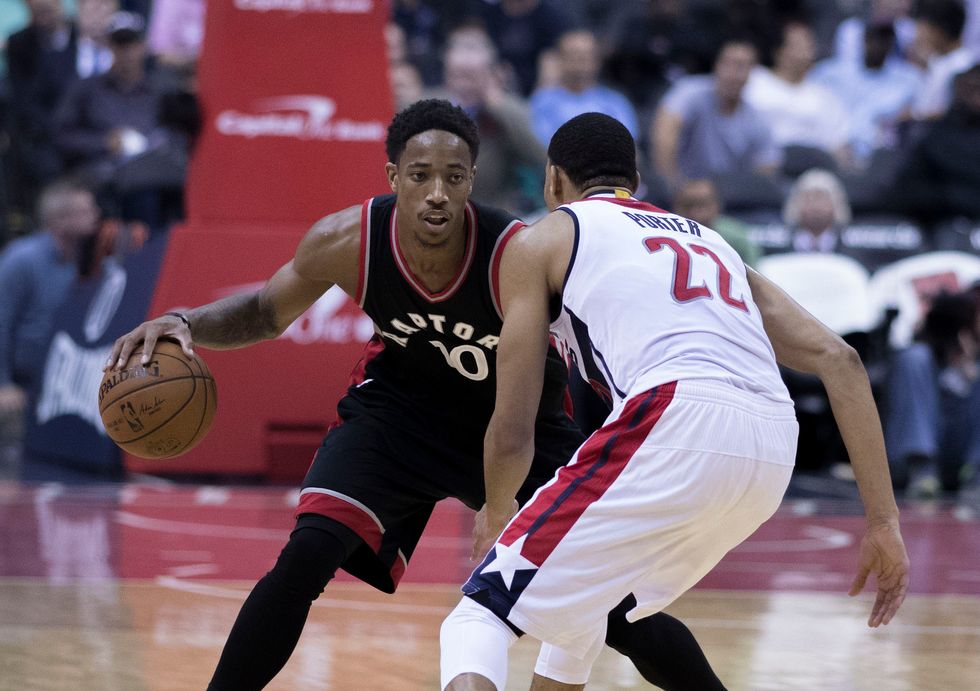Just two days after getting swept by Cleveland in last year’s playoffs, Toronto Raptors' GM Masai Ujiri discussed his team’s need for a “culture reset,” specifically, adjusting their style of play to catch up to the rest of the league. Fast forward 10 months and the Raptors begin the second half of the season as the best team in the East, proud owners of a franchise-best 41-16 record before the All-Star break and 8.5 point differential that puts them just behind Houston at the top of the league. How did this ‘culture reset’ happen so easily and effectively, especially when their only new free agent signing last summer was veteran shooter C.J. Miles?
(All statistics courtesy of NBA.com as of February 20th)
Youth movement
Toronto has long had numerous young prospects sitting on their bench, but these players haven’t contributed enough in past years to make much of a difference for the Raptors; last year, Jakob Poeltl, Fred VanVleet, Pascal Siakam, and Delon Wright played just an average of 13 minutes per game. This year, they’re all playing around 20 minutes per game, taking the burden off of stars DeMar DeRozan and Kyle Lowry. Toronto hasn’t just been treading water with their leaders off the floor, either; their all-bench unit of Poeltl, VanVleet, Siakam, Wright, and Miles leads all eligible five-man units with +114 points per 100 possessions. With a team that has 11 players averaging at least 16 minutes per game, the Raptors have plenty of depth to throw at opponents come playoff season.
Versatile defense
By trusting in their young players, Toronto has also improved its already solid defense. Head coach Dwane Casey has given plenty of minutes to wings like rookie OG Anunoby, Wright (a large, 6’5” point guard), Siakam (a long, athletic power forward), and the small, but pesky, duo of VanVleet and Lowry, resulting in a much more versatile and stingy defense. Anunoby, who returned from an ACL injury almost two months ahead of schedule, has been particularly impressive as a defensive wing who can guard all five positions, and he quickly earned a starter spot in his rookie season. Poeltl has been a positive defensive player as well, averaging 1.2 blocks per game. Toronto has completely modernized their defense to emphasize versatility, length, and switching, and they have jumped all the way to the third-best defense in the league as a result!
New-look offense
The Raptors have ranked in the top 10 in offense for four straight seasons. However, in the playoffs, they’ve collapsed on that side of the ball for three straight post-season runs with both DeRozan and Lowry struggling to score against more focused, disciplined defenses. Casey adjusted his offense this season to solve his team’s problem of relying on isolations from their two stars, and the results speak for themselves:
The Raptors have taken a significant step away from the mid-range game by taking seven more threes per game than they did last year in order to improve their offensive efficiency. VanVleet and Miles have been the difference here, but the whole Raptors team has started taking threes; Toronto has eight different players taking at least two threes a game. This includes notable mid-range specialist, DeRozan, who has improved his three-point percentage dramatically. He is shooting 37% on catch-and-shoot threes this season.
Casey has also improved the team’s ball movement and flow; thanks to their improved floor spacing, off-ball cutting, and emphasis on making the extra pass, their assist/turnover ratio now ranks fourth in the league, up from 25th last season. They’ve been able to move away from their reliance on the one-on-one abilities of Lowry and DeRozan, who are trading stagnant isolations for ball movement and cutting. DeRozan, in particular, has taken a big step forward; not only is he generating more space for others with his improved three-point shot, but he has also improved his ability to collapse defenses and make quick passes to open teammates to the tune of a career-high of 5.2 assists per game.
Toronto is also pushing the ball in transition; they’ve moved from 24th in pace to 11th, and they are getting 12.6 fast break points per game because of it. Even when they don’t immediately get transition baskets on their fast breaks, pushing the pace gives the Raptors more time on the shot clock to run their half-court offense and find the extra pass for an open three-point shooter. It can also force mismatches for DeRozan and Lowry to attack for easy scores.
Playoff questions
Despite a terrific season so far, Toronto still doesn’t seem like the obvious favorite to reach the Finals this year. They have no dominant superstar player; DeRozan is nowhere near Harden, Curry, Durant (yes, the Warriors have two superstars), Irving, or LeBron. Relying on team basketball will only get you so far in the playoffs; as defenses are able to focus on individual team tendencies, they become much more prepared to slow down and attack role players like Siakam and VanVleet. DeRozan’s inability to take over playoff games, as demonstrated in his recent post-season struggles, means that the Raptors will have to prove that they can beat playoff teams with their depth, instead. The results so far this season have been mixed; Toronto has gone just 7-8 against top five teams in either conference. Their true test will come in their two trips against the new-look Cavaliers, as well as their lone game this season versus the league-leading Houston Rockets. Even in their best season yet, Toronto will have to overcome a lot of doubt and adversity in the playoffs and defeat the best player in the world in order to reach their first Finals in franchise history.



















